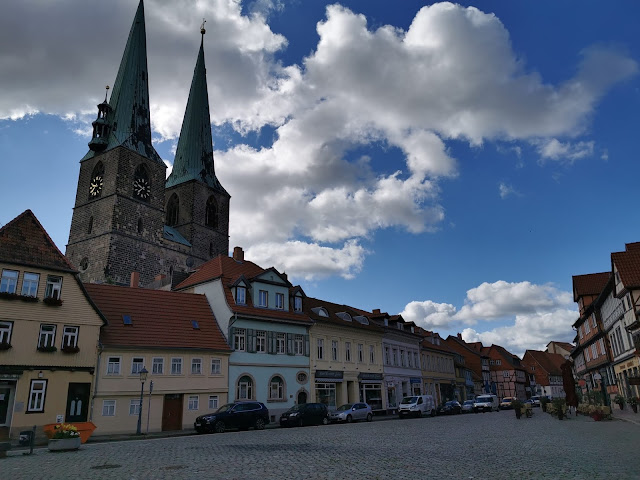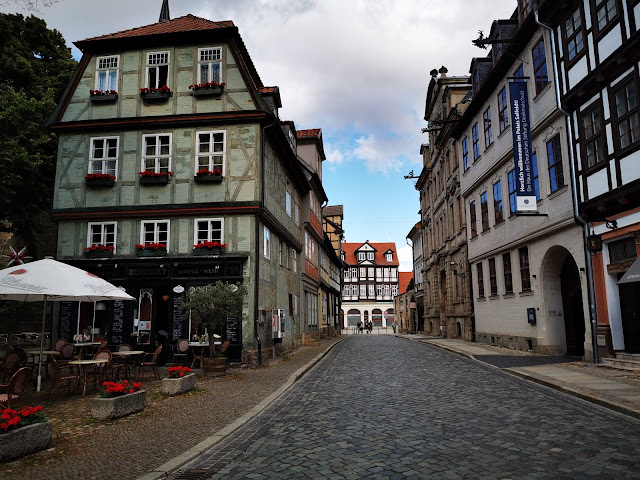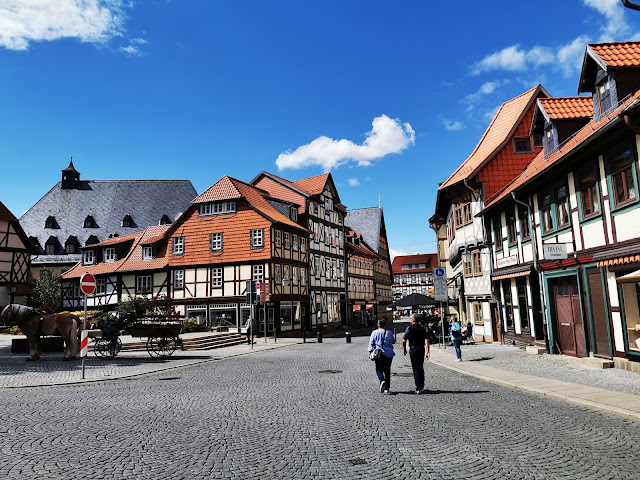I took a train from Verona to Berlin as my flight had been canceled, due to the covid restrictions, and a few days after being in the city, my girlfriend and I decided to make a day trip. I chose to visit three towns close to the Harz mountains which I had wished to visit for a long time. We took an early train from Berlin and used the Quer-durchs-Land ticket which allows unlimited travel on the regional trains network all over Germany for one day. We arrived in the first town, Quedlinburg, quite early, and immediately headed towards the city center from the local train station. As we walked through the pretty streets we admired the beautiful architecture made up of typical timber-framed houses. In fact, Quedlinburg contains about 2000 timber-framed historical buildings and its old town is one of the largest in the country. It survived quite unscathed during its history and particularly during world war 2, and since 1994 it was declared a world heritage site by Unesco. At one point we passed by the Nikolaikirche, a nice church built in a mix of Romanesque and Gothic styles, with twin bell towers measuring up to 72m in height. It was unfortunately closed so we continued on passing through the nice Polkenstrasse which resembles more a tiny town square. A little further we then reached another Gothic church, that of St Benedikti, which this time was open. The interior featured a nice vaulted gothic ceiling with a late 14th-century choir holding a baroque wooden altar. From that church, we continued onwards and reached yet another church, that of St Aegidii. It was closed, but a man that was passing nearby saw we tried to enter and told us he would open the church for us. Built in a Gothic style it features three naves with a simple barrel ceiling and a really nice winged altar from the first half of the 15th century and representing the coronation of the Virgin Mary. After thanking the old man who opened us the church and leaving a donation within, we headed on and shortly after came upon the nice Schreckensturm, one of the tall medieval towers that used to dot the walls of the city. The walls and towers can still be seen when walking around however the city gates have all but been demolished. Later on, we passed another of these towers, the Lindenbeinscher Turm, which during the summer months can be climbed to the top to have a beautiful view. A turn left from there then led us to the city's main square, the pretty Marktplatz. To the north is the beautiful Rathaus, or town hall, which at that time featured a most picturesque arrangement of ivy and flowers covering it. Built during the 14th century, it was refurbished in 1616 when it received its current stone facade. It is considered as one of the oldest and most beautiful town halls in Germany and rightly so. In front of it stands the typical Roland statues, the symbol of the town's privileges during the middle ages, this one dating to the 14th century and is considered as one of the oldest and the second smallest of all Roland statues. As we crossed the square which was currently full of people and food and shop stalls, we reached the southern end where the church of St Blasii is located. Featuring a Gothic exterior with a single bell tower, the inside was completely refurbished during the 18th century and has a nice wooden gallery ending in a pompous baroque altar. Following then a pretty street lined by a canal known as the Mühlgraben, we came across an unusual timber-framed house, which, as the signpost next to it said, was the oldest in town, dating to about 1347. Nex to it was the Fleischhof, a nice medieval courtyard with a wooden tower at its center and all around a nice timber-framed building. We then continued on passing through another nice area, called Finkenherd, located just below the hilltop where the famous Quedlinburg Abbey is located on. From there we in fact took a staircase which led us to the top, where we found a beautiful garden filled with blooming flowers that granted us an incredible view of the old town below. From the terrace, we then decided to visit the main monuments located there, the castle and abbey. In fact, it is here that in 936 on the initiative of the widow of the East Frankish King Henry the Fowler, Saint Mathilda, an abbey was founded as a memorial to the late king. During its history, until 1803, it was an imperial estate and a self-ruling imperial abbey of the Holy Roman Empire, thus very powerful and independent, ending up also in a long dispute with the town of Quedlinburg itself on the land and rights of the area. We headed to the ticket office and found out, that due to the reconstruction of part of the complex, the castle museum was unfortunately closed and part of the church itself was full of scaffolding. We headed in either way as we were there already and entered the main nave of the Romanesque abbey church. This was the part of the church with the most scaffolding and unfortunately, many of the beautifully decorated capitals of the columns were hard to admire like that. Below the nave, though, the crypt was fully open and featured some nice capitals with animal representations and geometric motifs. Upstairs again, behind the main altar was a series of two small rooms where the treasure was exhibited. It featured some beautiful golden reliquaries, monstrances, etc. some dating as early as the 7th and 8th centuries such as the west franconian ivory box known as the Servatius reliquary. There was even a 1st-century alabaster jug known to be the jug used in the wedding at Cana. After the visit to the church, we headed back down the hill and walked up the front-facing hill known as Munzenberg. This nice hill is covered in pretty half-timbered houses and medieval streets and grants a beautiful view over the old town of Quedlinburg and the hill topped by the abbey. Once we had seen enough it was time to head back through the city center, admiring the beautiful architecture and walking once more through the lively main square, until we reached the train station from where we took a train to the next town: Halberstadt. Unlike Quedlinburg, which had survived world war 2 relatively unscathed, Halberstadt was heavily bombed and nearly 80% of the city center, razed or damaged. It was rebuilt in the following years and despite the modern ugly buildings here and there a nice job was done. After getting off the train we reached the city center and passed by the old town hall, which was completely reconstructed after the war, on the southwestern corner though stands the stone figure of the Roland, which survived the war and is thus one of the oldest in the country. Nearby we then entered and visited the church of St Martin, also partly rebuilt after the war. It features a nice Gothic style with a pair of bell towers, one of which shorter than the other. The interior, also Gothic, was airy and light and featured a beautiful bronze baptismal font from the 13th century with intricate decorations and figures. It was also still featuring vivid colors which is a rare thing. There was also a very nice baroque wooden altar dating from 1696 and a renaissance pulpit from 1595. After seeing the church we then headed on and reached the main square, the Domplatz, a rectangular open area with trees and at its eastern and western end two of the town's main monuments, the Cathedral and the Liebfrauenkirche. We decided to see the largest and most important first, the Cathedral. Dedicated to St Stephen and St Sixtus, it was built in a Gothic style between 1236 and 1491 and replaced an older romanesque one. The type of gothic was interesting though as it was rather different from other german ones and in fact was inspired by the french gothic cathedrals. As we entered inside we marveled at the height and length of the main nave, with high vaulted ceilings and large decorated pillars separating it from the minor naves, typical of the gothic style. Right after the entrance at the center was a nice Romanesque baptismal font which came from the earlier church and above it a large wooden baroque organ. At the end of the main nave, separating the chancel from the nave, was a nice rood screen which was unfortunately partly covered in scaffolding. To the sides of it a hallway led around the apse and into some back chapels all decorated with beautiful stained glass windows. some of which even surviving the bombings and dating to the 14th and 15th centuries. A door next to the Cathedral then led to the treasury which we decided not to visit at the time and instead move on to see the rest of the town. We crossed the square in front, passing by the nice 16th century Drompropstei, once the residence of the provost, and then reached the other church, the Liebfrauenkirche, or Church of Our Lady. Built in the Romanesque style, it is apparently the only surviving four-tower basilica from the Romanesque period in central and northern Germany. Its interior was quite mediocre and empty looking, and a wedding had just finished so we didn't have time to fully explore it in detail, but we managed to visit the nice courtyard which, unlike other cases, was actually in front of the facade, rather than on the side of the church. It featured nice arched galleries with ancient pieces such as friezes and fonts on display, and at the central a lush green garden with tall trees. From the church, we then continued on and walked through Halberstadt's nice streets, some of which featuring some nicely decorated timber-framed houses. It was time to head back to the train station from where we took the next ride to the final stop of this trip, the town of Wernigerode. Located on the northern slopes of the Harz mountains, and thus the closest of the three towns to the mountain itself. After reaching the town's station and getting off the train we headed in the direction of the old town and came across the church of St John, a nice Romanesque style church which was unfortunately closed. Continuing on we then reached the main street which was filled with people, mostly tourists enjoying the nice day in the city. The street was lined with nice timber-framed colored houses and led us eventually to the town's main square, the Marktplatz. At its center stands a nice baroque fountain while the southern part of it is where the peculiar town hall is located. One of the most beautiful in the country, that I had seen so far at least, it features a timber frame style with tall slender towers on the side of the elaborate facade. Not far from it we then reached the church of St Silvester, with its tall thick tower and featuring a Romanesque style, being the town's oldest church. It was closed as well so we continued on, admiring the nice picturesque architecture of the old town. We passed what is considered as the smallest house in the city, where many tourists were lining up to take a picture and continued on now deciding to head up one of the surrounding hills where the city's main monument is located, the castle. It took quite a bit to reach the top of the hill where the imposing structure of the Schloss is located. Here, we had an amazing view of the old town below and the surrounding foothills of the Harz. We passed through the nice frontal garden and then headed to the entrance of the complex where we bought the ticket and were showed inside. The castle's appearance is now due to the restructuring it underwent at the end of the 19th century and is thus a clear example of German Neo-Romantic style, such as the famous Neuschwanstein castle. However, this castle has much older roots and foundations and was in fact the seat of the counts of Stolberg-Wernigerode since its construction during the 13th century. So as we admired the many rooms that filled the interior of the complex, we learned about the family and particularly Count Otto who was also Germany's first Vice-Chancellor and who had the castle rebuilt in its current form in 1893. The furniture of the room was an attempt to imitate and recall what was considered as the perfect style in history, Gothic in that case. There was some wooden furniture, some of which a revival and imitation, while other originals taken from other places around the county. It was definitively to my taste as I had always wished for a wooden gothic library in my future home. Once we had seen the whole complex we decided to head back downhill and stroll through the rest of the town before finally heading back to the station where we took the next ride in the direction of Berlin, tired but satisfied after a long and nice trip.























No comments:
Post a Comment